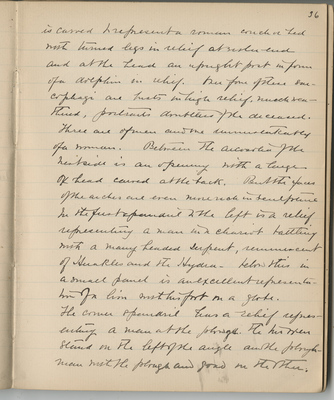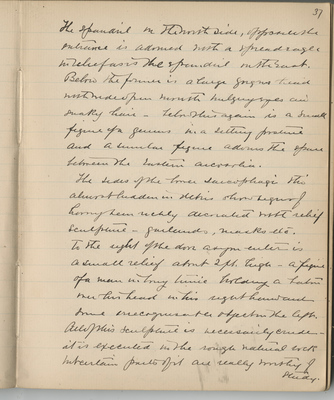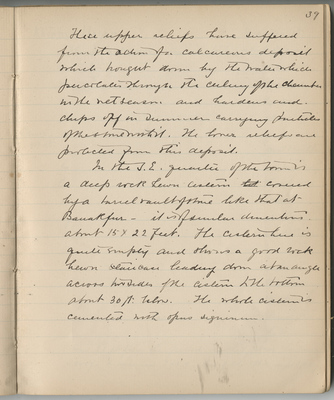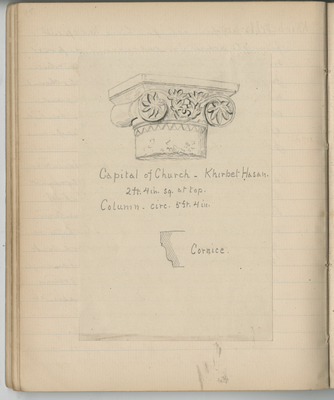Pages
BSY_FB_06_p036
36
is carved to represent a roman couch or bed with turned legs in relief at either end and at the head an upright post in the form of a dolphin in relief. Over four of these sarcophagi are busts in high relief, much weathered, portraits doubtless of the deceased.
Three are of men and one unmistakably of a woman. Between the arcosolia of the west side is an opening with a large ox head carved at the back. But the faces of the arches are even more rich in sculpture. In the first spandrel to the left is a relief representing a man in a chariot battling with a many headed serpent, reminiscent of Herakles [sic-Heracles/Hercules] and the Hydra - below this in a small panel is an excellent representation of him with his foot on a globe.
The corner spandrel has a relief representing a man at the plough. His two oxen stand on the left of the angle and the ploughman with the plough and goad on the other.
BSY_FB_06_p037
37
The spandril on the north side, opposite the entrance is adorned with a spread eagle in relief as is the spandril on the east.
Below the former is a large gorgon head with wide open mouth, bulging eyes and snaky hair. Below this again is a small figure of a genius in a sitting posture and a similar figure adorns the space between the eastern arcosolia.
The sides of the lower sarcophagi tho' almost hidden in debris show signs of having been richly decorated with relief sculpture - garlands, masks, etc.
To the right of the door as you enter is a small relief about 2ft high - a figure of a man in long tunic holding a baton over his head in his right hand and some unrecognizable object in the left.
Although this sculpture is necessarily crude - it is executed in the rough natural rock but certain parts of it are really worthy of study.
BSY_FB_06_p038
38
The lower portions seem to have been worked in better material - here the sculpture is better preserved. The ornament of the conches, the masks and garlands of the lower row of sarcophagi, the squatting genii, the head of Medusa and the little lion are works of excellent decorative style.
The busts and the spandril sculptures are executed in crumbling rock and are badly weathered. One notices however, in the group particularly a lack of proportion in the human figures while the perspective of the two oxen is good. The busts are really too badly weathered for me to judge fairly. They are very simple with drapery about the shoulders of Roman style. Otherwise they are strongly reminiscent of Palmyrene busts. The single figure on the south side is quite unlike the other reliefs in composition and treatment. It is ill proportioned but spirited in action it is very badly weatherworn.
BSY_FB_06_p039
39
These upper reliefs have suffered from the action of a calcareous deposit which brought down by the water which percolates through the ceiling of the chamber in the wet season and hardens and chips off in summer carrying particles of the stone with it. The lower reliefs are protected from this deposit.
In the S.E. quarter of the town is a deep rock hewn cistern crossed by a barrel vault of stone like that at Banakfur - it is of similar dimensions about 15 x 22 feet. The cistern here is quite simply and shows a good rock hewn staircase leading down at an angle across two sides of the cistern to the bottom about 30ft. below. The whole cistern is cemeted with opus signinum.
BSY_FB_06_p039back
[illustration, capital of church, cornice, at Khirbet Ḥasan]]





